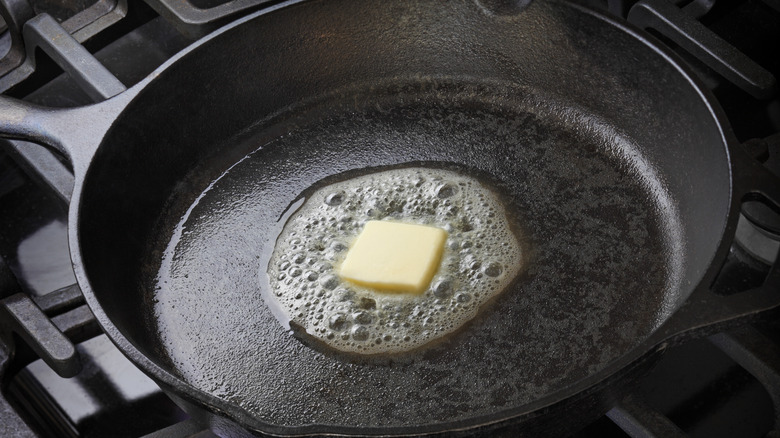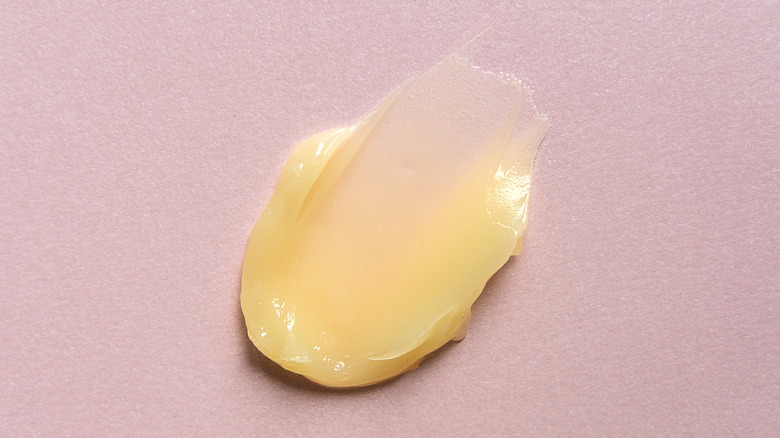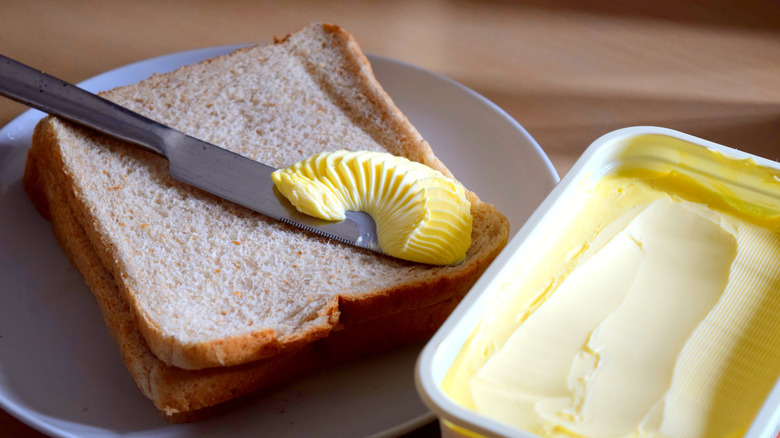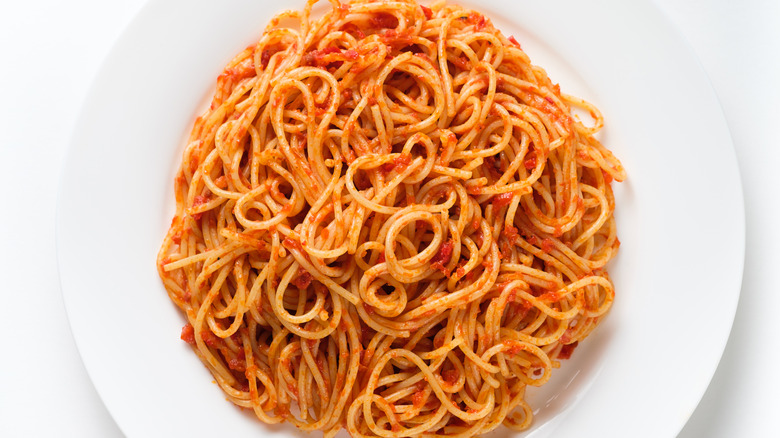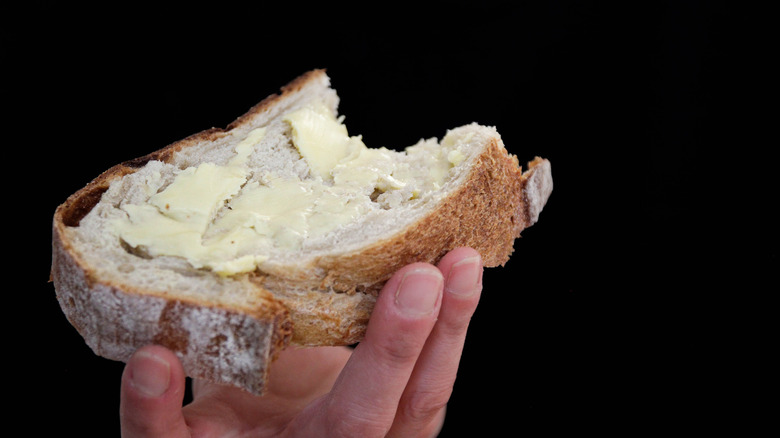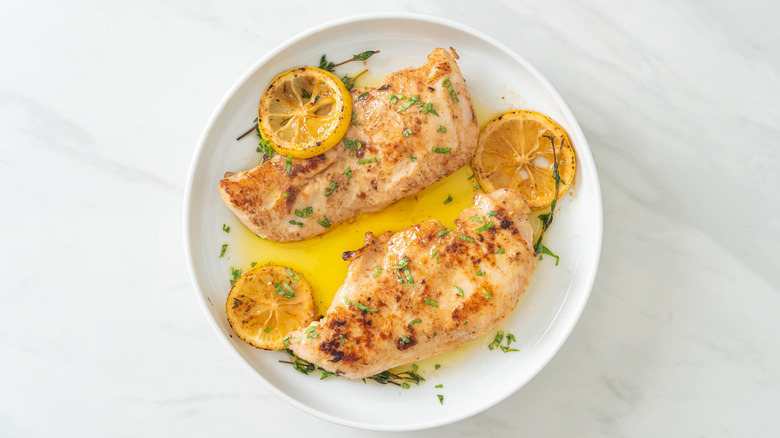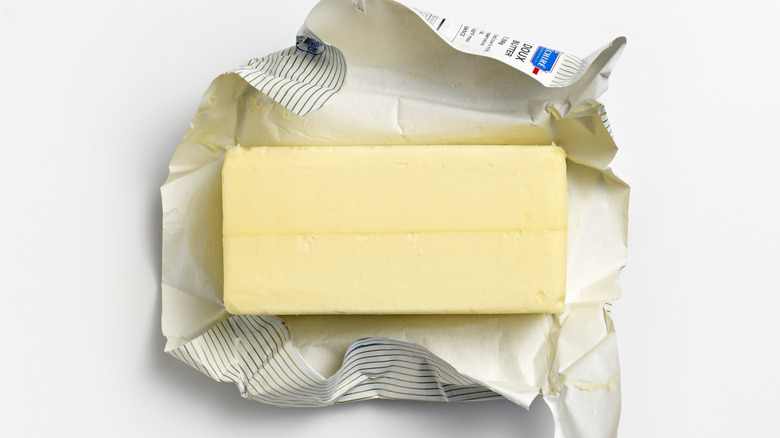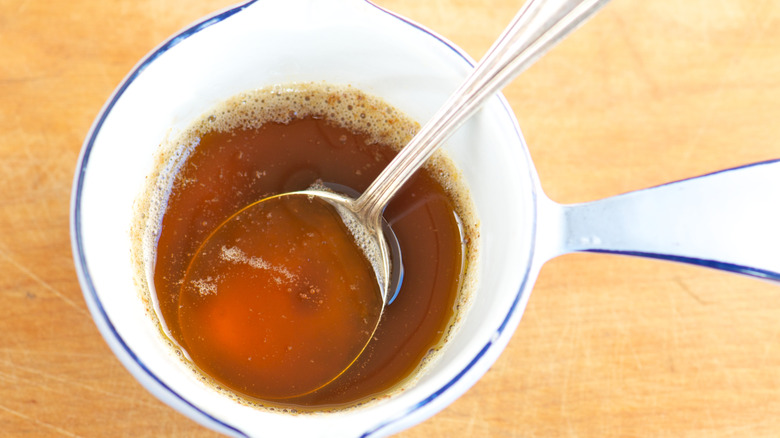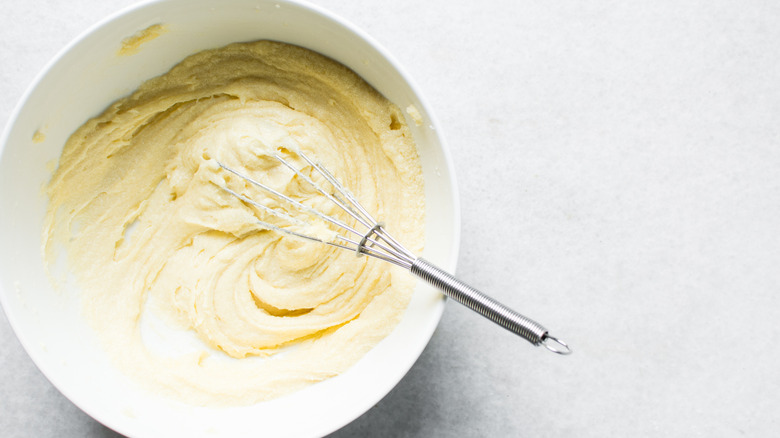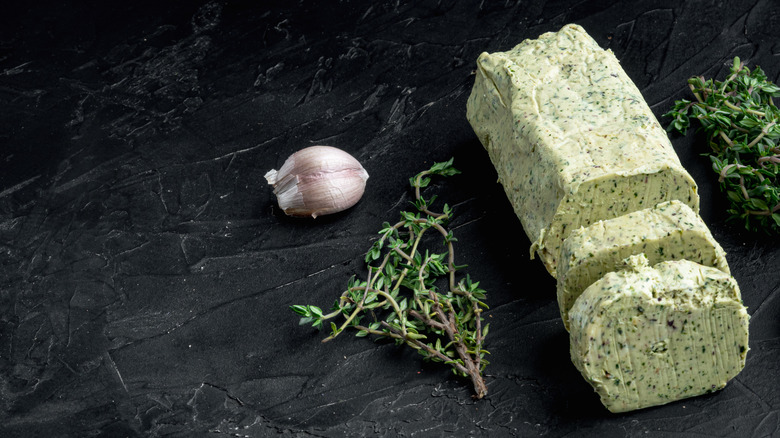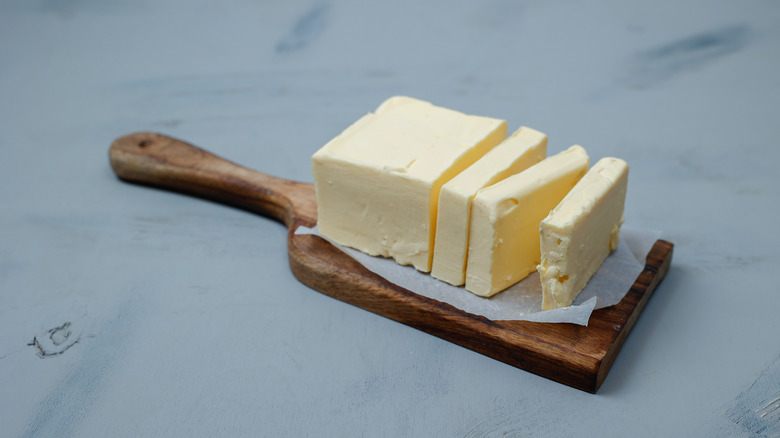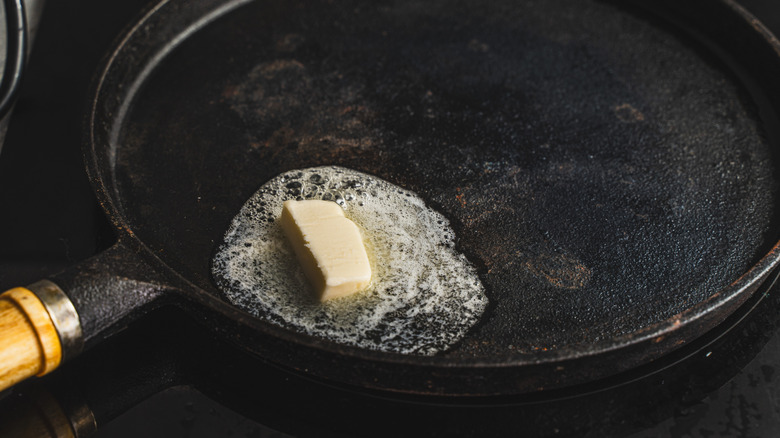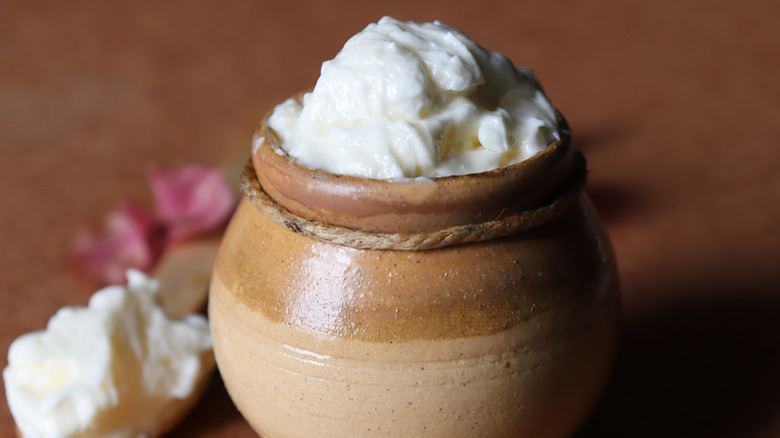14 Mistakes Everyone Makes Cooking With Butter
For people who eat dairy, there's one product that reigns supreme in the kitchen: butter. No matter what type of butter you're using, this ingredient brings a deeply creamy, rich flavor to your food, and it works in pretty much anything. It also seems deceptively simple to use: Most of the time, all you have to do is put a cube of butter into your dish and it will improve it tenfold, right? Well, while we wish that were the case, butter is one of those ingredients that's way more delicate than it looks. Getting it wrong may end up ruining your meal completely.
Many mistakes when it comes to butter occur because the person using it doesn't understand its fundamental structure. Butter gets its creaminess from its high level of milk solids, but these same solids are also what causes it to burn so easily. The milk solids in butter can also be altered when you cook butter for too long or too vigorously, and folks who add it to their food too early may find that its unique flavor has almost completely disappeared. Plus, a lot of people forget that butter may be good, but you can make it way better than you think. Grab your stick of butter, a knife, and some bread, and let's get started.
1. Mistake: Forgetting to soften your butter
Softening your butter is a vital step for plenty of baking recipes, but it's one that a lot of people forget about. Then, they're left with a cold stick of butter, a bowl of dry ingredients waiting for fat to be added to them, and a dilemma on their hands. Do they use their cold butter and hope for the best? Or do they put it in the microwave and pray that it doesn't melt?
Well, both things are huge errors. Using cold butter where room-temperature butter is called for may lead to poor distribution and a different texture, and using a microwave to soften your butter may cause it to melt, thereby making your food too greasy. Instead, you should always remember to soften your butter, ideally by leaving it out on the counter beforehand to bring it to room temperature. If you forget to do this, though, there are loads of butter softening hacks that you can do to soften it more quickly. By bashing your butter with a rolling pin or breaking it down to tiny pieces, you'll bring it up to temperature faster, and get it in your recipe in no time.
2. Mistake: Cooking your butter at a temperature that's too high
If you've cooked with butter a fair few times, you likely will have encountered this mistake — but if you're a butter rookie, it's easy to get caught out. Using your butter as a fat to cook your food creates a big risk of applying too high a temperature. If you cook your butter even a few degrees too high, it'll begin to burn and smoke, filling both your kitchen and your food with an acrid scent and destroying any luxurious quality it once had.
The smoke point for butter sits somewhere between 300 to 350 degrees Fahrenheit, depending on its specific structure. Any higher than this and it will start to degrade and burn. To avoid this, you should only ever cook with butter on a low to medium heat. If you know you're going to be using a high heat, mix your butter with some vegetable oil to raise the overall smoke point of your fats. Remember, too, that your butter may be better added towards the end of the cooking process to maximize its flavor potential, as well as to prevent it from smoking.
3. Mistake: Substituting butter for other fats and expecting the same result
We all know that everything's better with butter, but sometimes we just don't have it on hand. In those situations, it can be tempting to reach for another, similar-looking fat. Options like coconut oil or margarine have a similar consistency to butter, and seem to have that same creaminess that your favorite dairy ingredient provides. So they're basically a straight swap, right?
Not quite. While some fats look similar, you really do need butter to create that luxurious flavor, thanks to its milk solid content. Margarine, for example, has a different structure and is made from vegetable oil, giving it a somewhat greasy feel and flavor. Coconut oil, meanwhile, is made from (you guessed it!) coconuts, but has a fairly neutral taste and none of that deep creaminess that butter has. Of course, we recognize that sometimes you don't have the choice to use butter, especially if you follow a plant-based diet — and in these situations you may have to opt for a non-dairy option. However, you will lose that creaminess that butter has in spades.
4. Mistake: Adding butter too early in your cooking
If a recipe calls for butter, it can be easy to feel that you can add it whenever you want. After all, as long as the temperature isn't too hot and it won't burn on a scalding pan, then surely you can just throw it in, right? Unfortunately, that's not quite the case. Adding butter too early in your cooking can be a grave mistake as cooking it for too long can both ruin its flavor and destroy its texture. Butter is an emulsion, and its specific combination of water and solids is what gives it its creamy flavor and texture. If you cook it for too long, however, that emulsion breaks down and the water in your butter will evaporate. This will then split whatever sauce you're making with it, and result in the flavor being altered irreparably.
Instead, you'll likely want to hold off on adding your butter until the end of your cooking process. When you do this, it will retain its creaminess and luxurious quality. Plus, it will also retain its structure, and thicken your pasta sauce instead of splitting it. Make sure you're adding your butter to your pan when it's still room temperature or cool, though: Adding it when it's melted can stop it from incorporating as well.
5. Mistake: Forgetting that different types of butter will produce a different result
Look, we get it. Butter is pricey, and you might not have the money to spend on the highest-quality stick you can find. In those situations, it's natural to reach for the cheaper butters on the shelf. However, if you're doing this, you really shouldn't expect your food to taste how it would if you're using the more expensive options.
Generally speaking, more expensive butter has a higher milk fat content, and this increased content gives it a creamier nature. Cheaper butter, on the other hand, has a lower milk fat content and more water. In some cases, products labeled as having "butter flavor" or being "made with real butter" may also contain other ingredients like vegetable oils or emulsifiers. As such, if you want the richest taste, you need to go for a more expensive choice.
However, it's also worth remembering that there are some occasions where cheaper butter is best. Butter with a higher water content will usually produce crispier bakes, and so if you're looking for cookies that have a good snap, it could be a smart choice. On the other hand, more expensive butter will give you a flakier, softer end result that tastes richer.
6. Mistake: Not balancing your butter's flavor with other ingredients
Throwing butter into a dish is usually never a bad idea, but you shouldn't do so at the expense of other ingredients. It's important to remember that butter is a powerful-tasting foodstuff: Its intense creaminess can complement dishes, but it can also overpower them, leaving things tasting buttery with no sense of balance. If you fail to then redistribute flavor by adding other ingredients, then your dish will never be completely finished — and it won't taste as good as it could.
So, remember the art of balancing your flavors. If you're adding creaminess by including butter, ensure that you're also adding an acidic element like lemon juice or vinegar. The acids will cut through the creamy notes and stop them from overwhelming everything else in the dish, and will also add complexity and depth to your meal. Plus, that bitterness will also highlight other flavor notes in the food, like sweetness or saltiness, bringing everything to the fore and making your dish taste truly alive. By contrast, if you find that your dish is a bit too acidic, leveling it out with some butter can reduce astringency.
7. Mistake: Not using good-quality butter to finish your dish
There are times when using a lower-quality butter can come in handy. If you're just spreading a little bit of butter on your midweek toast, or looking to make a crunchy cookie, then you can kinda get away with the cheap stuff. However, if you're finishing your dish with butter, you should always go for the top-shelf options. Using low-quality butter to finish a dish will not only give it an underpowered flavor, due to the lower amount of milk solids, but the higher water content in cheaper butter can introduce too much moisture to your dish. As a result, your food may be watery and lacking in flavor.
Opting for good-quality butter, on the other hand, will give you that creaminess that you're craving. Good-quality butters also have a surprising amount of complexity in them, with a touch of sourness that stops them from being relentlessly cloying and milky. European-made butters can be a great option, with brands like Kerrygold, Président, and Colliers making consistently good products. However, retailers like Trader Joe's can stock European-style butters which are excellent quality and have that high butterfat content and depth that you're craving. Just make sure you're saving this butter for those times you want to impress, though.
8. Mistake: Swapping salted for unsalted butter (and vice versa) without thinking about the impact it makes
It's no secret that salted and unsalted butter taste different, but surely swapping them isn't the end of the world, right? Well, no, it's not — but it can make quite a big difference. Unfortunately, a lot of people forget this, and reach for one when they're out of the other. Then, when they come to eat their food, they're slightly disappointed with the final result.
The problem with swapping salted butter for unsalted (and vice versa) is that it's difficult to tell exactly how much salt is in the salted version. Therefore, if you're using unsalted butter instead, you can easily either over- or under-season your food with added salt, and make it too salty or not salty enough. When doing the opposite swap, you may end up oversalting your food unintentionally. This can particularly be the case when you're using salted butter in a baking recipe that calls for the unsalted version, which can leave your food tasting overly briny, getting in the way of its sweetness.
However, it's also true that there are certain situations where swapping one for the other really isn't an issue. If you're using your butter to finish a sauce, for example, you can use salted or unsalted. Just use a bit less salt in the sauce if you're going for the salted version.
9. Mistake: Forgetting to brown your butter
If you've never browned butter before, you're seriously missing out. Browning butter unlocks a completely new world of flavor and depth in the fat by toasting the milk solids in it. This toasting gives the butter a caramelized, nutty taste, which you can then infuse through anything you choose. Don't worry, it still retains its deep, smooth creaminess — it just kicks things up to the next level.
It's worth remembering, though, that browning butter can be a little trickier than it seems. Cook it for just a little too long, and it will burn instead of brown. As such, one tell-tale sign that your butter is ready is that it stops bubbling and the pan becomes completely silent. When it does this, it's time to take it off the heat, so that it doesn't scorch. You're also going to want to use unsalted butter for brown butter, as it's easier to judge exactly when it's cooked due to it foaming less in the pan.
10. Mistake: Not creaming your butter for long enough
For many baking recipes, creaming your butter is essential. The creaming process involves mixing butter and sugar together until it's blended together, fluffy, and airy. While this may seem like a hassle to do, it's a vital step as it helps the sugar in your recipe distribute properly, giving you an even flavor throughout your bakes and preventing any clumps of sugar forming. It also introduces air into your recipe, which makes things lighter and fluffier.
However, creaming butter can take way longer than you think, and a lot of people stop before it's completely done. This can sorta ruin your recipe. If you don't cream your butter for long enough with your sugar, then the sugar won't dissolve properly. As a result you'll end up with a gritty consistency that leaves bits of sugar stuck between your teeth. You also won't introduce enough air into the butter itself. Having said this, you also don't want to cream your butter for too long, as it will separate and lose any buoyancy it once had. Creaming butter and sugar usually takes a few minutes in a mixer at medium-high speed.
11. Mistake: Forgetting to make compound butter
Regular butter is good, but compound butter is better. Compound butter is made by combining regular butter with whichever additions you care to add. You can make spiced compound butter by mixing it with cinnamon and ground cloves, or go for a herbal one by combining it with chopped parsley and coriander. It can be used in sweet or savory applications, and it's a guaranteed way to add flavor to your dish, with the butter fats bringing the ingredients in it to life.
Despite this, it's incredible how few people actually use compound butter in their recipes. This might be because they're slightly intimidated by making it, and view it as needlessly fussy or cheffy. That's really not the case, though. Compound butter can be made in mere minutes, and once it's put together it can be kept in the fridge for a couple weeks. Alternatively, you can freeze it until you're ready to use it next. If you're making compound butter, though, just make sure you use the best butter you can afford. You don't want to go to all that effort to produce something that's slightly subpar, taste-wise.
12. Mistake: Breaking up your butter into different-sized pieces when cooking
Butter melts quickly, but sometimes it doesn't melt as quickly as we'd like. We can help it along by breaking it down into smaller pieces — but if we don't do this evenly, we can be left with a slight problem. When we break up butter into different-sized pieces it can melt at a different rate, and if you're using butter to finish a dish then this can leave you with uneven distribution. Some of your butter will be melted, while the other parts will still be whole, leaving you with chewy bits to wade through.
Using different-sized pieces of butter can also be an issue if you're making brown butter. Your butter needs to melt and caramelize at an even rate, and if it doesn't then you can end up with an inconsistent result that has a varying flavor. You can prevent this by dicing up your butter beforehand into even chunks, ensuring each piece is the same size.
13. Mistake: Using a dark pan when making brown butter
Anyone who's made brown butter before will know how quickly things can go wrong. In a second, your butter can go from beautifully nut-brown to black and glued to the bottom of your pot. This is way more likely to happen if you're using a dark pan to cook it in. When you cook brown butter in a black or dark pan, it's much harder to assess the exact shade of it, and you can end up with it getting burnt way more easily.
Instead, you should try to use a light pan wherever possible. White-based or silver pans work best here, as they offer a contrast to the butter that allows you to easily assess its shade. If you do have to use a dark pan, you may want to keep a tablespoon nearby. As your butter is cooking, you can take a little spoonful of it out every now and again to check its shade.
14. Mistake: Substituting homemade butter for store-bought and expecting the same flavor
Whether you're using store-bought butter or opting to make it yourself is up to you — but whichever you choose, you should remember that they're a little different. Homemade butter generally has a creamier, fresher taste than store-bought butter, because it's made there and then instead of being processed and shipped. It can also have a fluffier consistency, whereas store-bought butter can feel more solid and compact.
Whichever you choose, your butter will still be delicious. However, if a recipe specifically calls for homemade butter, it's likely doing so because it's aiming for that creamy note. If you're daunted by the prospect of homemade butter, don't be: It's super simple. You just have to whip heavy cream in a stand mixer for a couple minutes until it separates. If you're doing this, just make sure you're using the best-quality cream you can, as your butter will only ever be as good as the base product you're using.
